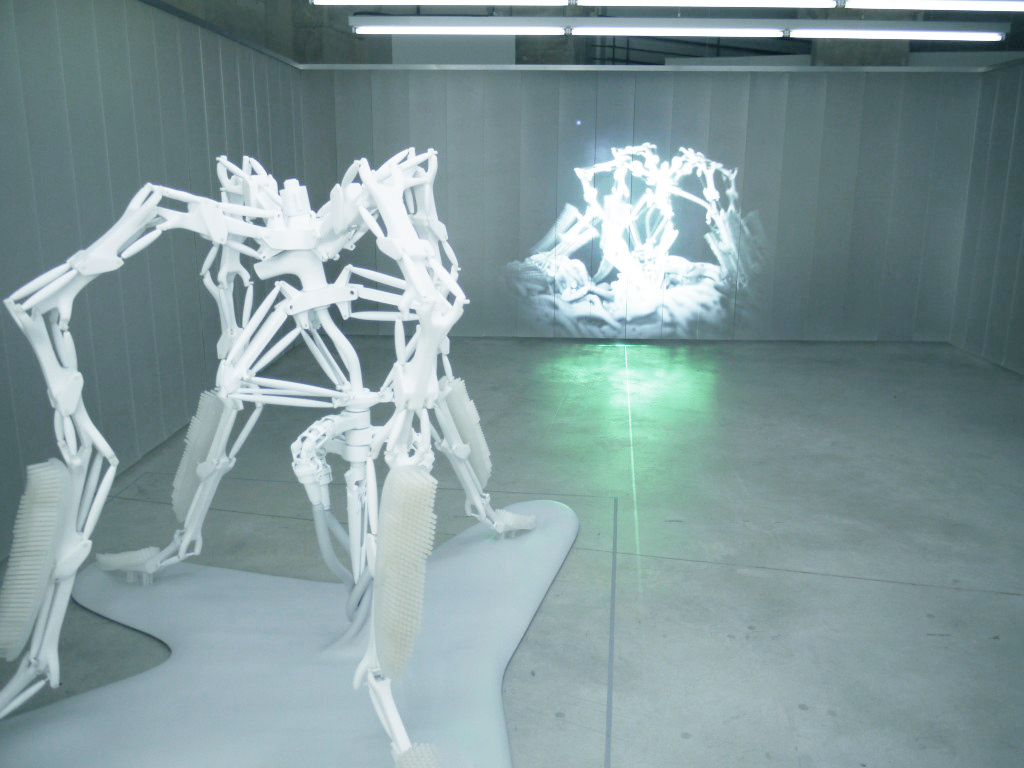Exhibition Design
Invite the visitor to take part in the revealed univers, unrolling step by step the story, artwork by artwork. Stage each piece into space, creating a visual composition tight to the required conditioning and through a meticulous installation.
Selected work
Event Horizon by Tomás Saraceno
Aria by Tomás Saraceno
On Air by Tomás Saraceno
A Thermodynamic Imaginary by Tomás Saraceno
Architecture des Humeurs by New Territories
~
Event Horizon
By Tomás Saraceno, at Cisternerne, Copenhagen, Denmark, 2020
Taking the unique environment of Cisternerne as his starting point, Saraceno has created a spectacular project which is different from everything he has presented so far, challenging the ways in which we communicate and navigate. The water that perpetually seeps through the concrete structure of Cisternerne forms a calm sea underground, and the exhibition must be experienced from boats.
Processes of nature and its transforming potential are a limitless source of inspiration for Saraceno. In this sense he seems the perfect match for Cisternerne; on one side the epitome of human civilization built as it was to provide the citizens of Copenhagen with clean water, yet on the other partly taken over by nature as stalactites grow from the ceiling and water consistently sinks in through the old concrete walls. Throughout his artistic praxis, Saraceno has explored alternative forms of life and dwelling based on studies in everything from astrophysics, philosophy and engineering to spiders and bats.
In Event Horizon, visitors travel Saraceno’s dark universe by boats. Like small isolated satellites, visitors float the exhibition rooms, passing by lit-up spiderwebs and gloomy spheres mirrored in the water’s surface as they navigate through the colonnades of Cisternerne. Through light and shadows the sculptures interact and converge like freefloating moons and planets, yet at the same time, locked in the orbit of the universe. Tangible spiderwebs connect us with the invisible – with air, sound waves, water and dust particles. The web in its essence points to the fact that we too are closely connected with and entangled in our surroundings, an environment itself made up of some of the smallest microbes of the universe. We affect our surroundings, just as we are affected by them and even the smallest acts can have great impacts on complex systems.
Processes of nature and its transforming potential are a limitless source of inspiration for Saraceno. In this sense he seems the perfect match for Cisternerne; on one side the epitome of human civilization built as it was to provide the citizens of Copenhagen with clean water, yet on the other partly taken over by nature as stalactites grow from the ceiling and water consistently sinks in through the old concrete walls. Throughout his artistic praxis, Saraceno has explored alternative forms of life and dwelling based on studies in everything from astrophysics, philosophy and engineering to spiders and bats.
In Event Horizon, visitors travel Saraceno’s dark universe by boats. Like small isolated satellites, visitors float the exhibition rooms, passing by lit-up spiderwebs and gloomy spheres mirrored in the water’s surface as they navigate through the colonnades of Cisternerne. Through light and shadows the sculptures interact and converge like freefloating moons and planets, yet at the same time, locked in the orbit of the universe. Tangible spiderwebs connect us with the invisible – with air, sound waves, water and dust particles. The web in its essence points to the fact that we too are closely connected with and entangled in our surroundings, an environment itself made up of some of the smallest microbes of the universe. We affect our surroundings, just as we are affected by them and even the smallest acts can have great impacts on complex systems.
A. Comet 11 Cyrtophora citricola (working title), 2013
H 90 x 90 x 90 cm (L2) / Spiderweb sculpture / Spidersilk, carbon fibre, metal, Dedolight, tripod
H 90 x 90 x 90 cm (L2) / Spiderweb sculpture / Spidersilk, carbon fibre, metal, Dedolight, tripod
B. Living at the Bottom of the Ocean of Air (Underwater Spider), 2018
Two screens: H 130 x 200 cm & H 180 x 330 cm / Media installation / Single channel video, 16:9, FullHD, black and white. Dolby 5.1 sound, 9’10’’
Two screens: H 130 x 200 cm & H 180 x 330 cm / Media installation / Single channel video, 16:9, FullHD, black and white. Dolby 5.1 sound, 9’10’’
C. Thermodynamic Imaginary, 2019
Various dimensions / Constellation of sculptures and projections / Various materials
Various dimensions / Constellation of sculptures and projections / Various materials
Photographs courtesy of Studio Tomás Saraceno

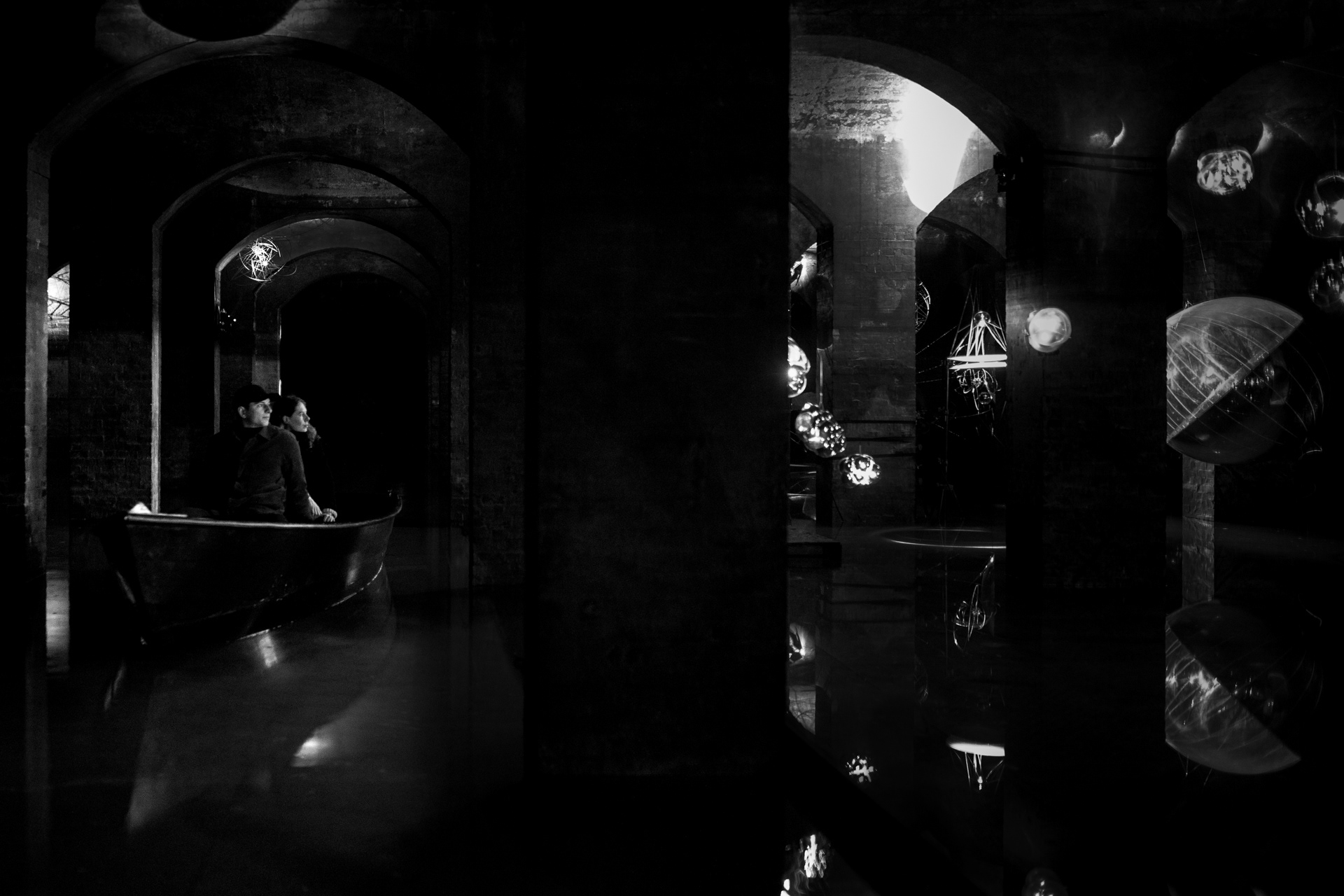


Aria
By Tomás Saraceno, at Palazzo Strozzi, Florence, Italy, 2020
Tomás Saraceno creates immersive works and participatory experiences that suggest a new way of living in our world by forging connections with such non-human phenomena as spiders, dust particles and plants, which become players in his works and metaphors of the universe.
As his work unfolds along a path from the courtyard to the exhibition halls of Palazzo Strozzi, Saraceno interacts with the historical context by creating an original dialogue between the Renaissance and the contemporary world – a shift from the idea of ‘man at the centre of the world’ to the concept of ‘man as part of a universe’ in which a new harmony can be sought.
Carbon emissions fill the air, particulate matter floats inside our lungs while electromagnetic radiation envelops the earth. Yet, a different epoch is possible, an Aerocene epoch – one of interplanetary sensitivity through a new ecology of practice. Ecosystems have to be thought of as webs of interactions, within which each living being’s ecology co-evolves. By focusing less on individuals and more on reciprocal relationships, we might think beyond what means are necessary to control our environments and more on the shared formation of our quotidian. Let the spiderweb guide here.
(Tomás Saraceno)
C. Thermodynamic Constellation, 2020
Ø 2.5 m, Ø 4.0 m, Ø 5.0 m / Inflatable sculpture / Mylar (transparent and metalized), mirrored acrylic plate, membrane pump with pressure control, overpressure release valve, PE tube, PES rope
Ø 2.5 m, Ø 4.0 m, Ø 5.0 m / Inflatable sculpture / Mylar (transparent and metalized), mirrored acrylic plate, membrane pump with pressure control, overpressure release valve, PE tube, PES rope
1. Connectome, 2020
Various dimensions / 1 Connectome and 4 mirror clouds / Various materials
Various dimensions / 1 Connectome and 4 mirror clouds / Various materials
2. Sounding the Air, 2020
5 threads, length 6 m / Media installation / Laptop, camera, mixer, stands, Dedolight, carbon sticks, spidersilk
5 threads, length 6 m / Media installation / Laptop, camera, mixer, stands, Dedolight, carbon sticks, spidersilk
3. Webs of At-tent(s)ion, 2020
Various dimensions / 5 Spiderweb vitrines / Spidersilk, carbon fibre, metal, glass, silicone, Dedolight, tripod
Various dimensions / 5 Spiderweb vitrines / Spidersilk, carbon fibre, metal, glass, silicone, Dedolight, tripod
4. How to Entangle the Universe in a Spider/Web?, 2020
H 1.2 x 5.0 x 1.0 m / Media installation / Spidersilk, mixed media, carbon fiber, laser
H 1.2 x 5.0 x 1.0 m / Media installation / Spidersilk, mixed media, carbon fiber, laser
5. Passages of Time, 2020
Various dimensions / Media installation / Spidersilk, carbon frame, light beam, cosmic dust, stellar wind, sonic waves, video camera, loudspeakers, video projector, projection tulle (H 2.8 x 5.0 m)
Various dimensions / Media installation / Spidersilk, carbon frame, light beam, cosmic dust, stellar wind, sonic waves, video camera, loudspeakers, video projector, projection tulle (H 2.8 x 5.0 m)
6. A Thermodynamic Imaginary, 2020
Various dimensions / Constellation of sculptures and projections / Variable Materials
Various dimensions / Constellation of sculptures and projections / Variable Materials
7. Arachnomancy, 2020
H 54.8 x 54.6 x 54.6 cm (Spiderweb vitrine) / Spider divination / Divination card deck, table, chairs, spidersilk, carbon fibre, metal, glass, silicone, Dedolight, tripod
H 54.8 x 54.6 x 54.6 cm (Spiderweb vitrine) / Spider divination / Divination card deck, table, chairs, spidersilk, carbon fibre, metal, glass, silicone, Dedolight, tripod
8. Flying Gardens, 2020
Various dimensions / Installation / Tillandsia plants, hand blown glass, monofilament, polyester rope, velvet rope, carbon fibre
Various dimensions / Installation / Tillandsia plants, hand blown glass, monofilament, polyester rope, velvet rope, carbon fibre
9. Aerographies, 2020
Various dimensions / Prints and drawings / Spidersilk, paper on MDF, Ink
(Connectome, 2020: H 205,5 x W 244 x D 4,7 cm / Tensile sculpture / Wood, polyester rope, monofilament)
Various dimensions / Prints and drawings / Spidersilk, paper on MDF, Ink
(Connectome, 2020: H 205,5 x W 244 x D 4,7 cm / Tensile sculpture / Wood, polyester rope, monofilament)
Photographs courtesy of Studio Tomás Saraceno


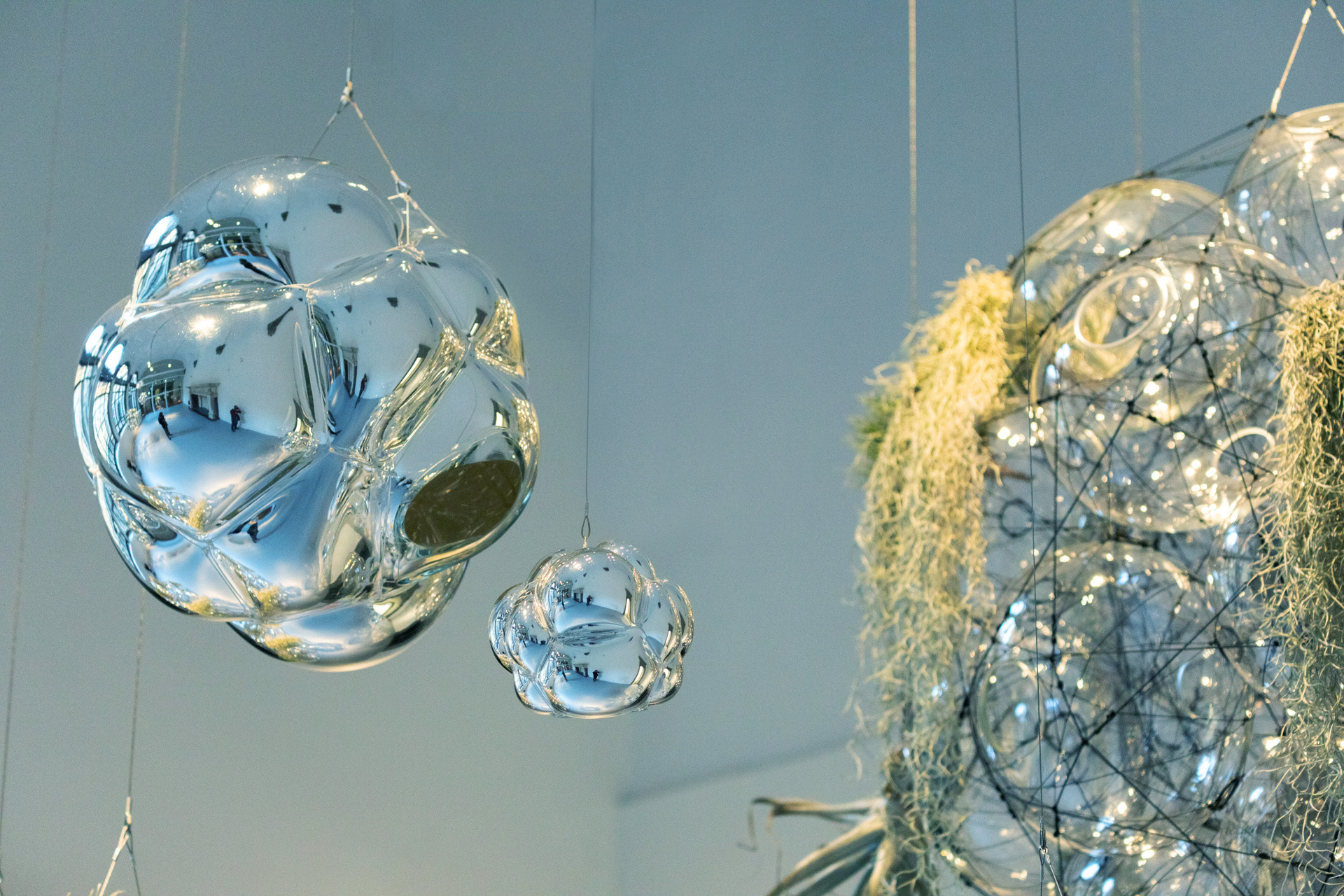



On air
Carte Blanche by Tomás Saraceno, at Palais de Tokyo, Paris, France, 2018
The exhibition ON AIR is an ecosystem in becoming, hosting emergent choreographies and polyphonies across human and non-human universes, where artworks reveal the common, fragile and ephemeral rhythms and trajectories between these worlds. As a hybrid ecosystem, ON AIR is made of a myriad presences, both animate and inanimate, that meet and cohabit within it. Some voices become quiet, whilst others, perhaps those less often heard by human ears, are magnified. The exhibition functions as an ensemble for silent voices, performing the hidden scores that link events and sensibilities, earthly and cosmic phenomena – weaving a web of relations that cannot be described but maybe can be felt.
ON AIR proposes a space and time that makes manifest the forces and entities that float in the air, and their interactions with us: from CO2 to cosmic dust, from radio infrastructures to reimagined corridors of mobility. Thus, the invisible histories that compose the ecologies we are part of invite us to poetically rethink different ways of inhabiting the world – and of being human.
While extractivist activities that mine the Earth for resources continue to threaten entire ecologies, ON AIR celebrates new ways of thinking about our relation with the planet, through new modes of knowledge production. This is to open itself up to the debate and global challenges posed by the Anthropocene, a word proposed to define the current epoch we live in on Planet Earth, in which some human activities leave an impact so important that they profoundly modify terrestrial ecologies. It is especially through the activities of Aerocene, an interdisciplinary artistic project initiated by Tomás Saraceno that seeks to reactivate a common imaginary to collaborate ethically with the atmosphere and the environment, that visitors are invited to collectively engage in an exercise of urgent planetary attunement.
ON AIR echoes the artist’s practice as it gathers numerous collaborators and collaborations, bringing together scientific institutions, research groups, activists, local communities, visitors, musicians, philosophers, non-human, and celestial phenomena, all of whom equally take part in the evolution of the exhibition. A series of workshops, concerts, public symposiums become part of a continuous process of transformation of the Palais de Tokyo into an evolving “cosmic jam session”.
1. Event Horizon, 2018
H 1.5 x 1.5 x 1.5 m / Media artwork / Speaker, Holocnemus Pluchei web, cosmic events live streamed from the VIRGO antenna at the European Gravitational Observatory (CNRS/INFN)
H 1.5 x 1.5 x 1.5 m / Media artwork / Speaker, Holocnemus Pluchei web, cosmic events live streamed from the VIRGO antenna at the European Gravitational Observatory (CNRS/INFN)
2. Webs of At-tent(s)ion, 2018
Various dimensions / 76 spiderweb frames / Spider silk, carbon fiber, lights, speakers
Various dimensions / 76 spiderweb frames / Spider silk, carbon fiber, lights, speakers
3. Sounding the Air, 2018
H 1.6 x 6.0 x 3.6 m / Media installation / Spider silk, carbon fiber, microphone, transducer, speakers, light , computer software , video camera
H 1.6 x 6.0 x 3.6 m / Media installation / Spider silk, carbon fiber, microphone, transducer, speakers, light , computer software , video camera
4. Passages of Time, 2018 (double projection)
A. 163,000 Light Years, 2016 - Single channel video, sound
B. Untitled, 2018 - Livestream of dust circulating in Particular Matter(s) jam session
A. 163,000 Light Years, 2016 - Single channel video, sound
B. Untitled, 2018 - Livestream of dust circulating in Particular Matter(s) jam session
5. Cross projection:
Interspecies Translator, 2018. Light beam, cosmic dust, terrestrial dust, pollen, soot, smoke, PM 2.5, stellar wind, sonic waves, video camera, loudspeakers, video projector, processor, dust tracking software
Aerosolar Journeys, 2018. Light beam, cosmic dust, terrestrial dust, pollen, soot, smoke, PM 2.5, stellar wind, sonic waves, video camera, loudspeakers, video projector, processor, dust tracking software, Float Predictor
Interspecies Translator, 2018. Light beam, cosmic dust, terrestrial dust, pollen, soot, smoke, PM 2.5, stellar wind, sonic waves, video camera, loudspeakers, video projector, processor, dust tracking software
Aerosolar Journeys, 2018. Light beam, cosmic dust, terrestrial dust, pollen, soot, smoke, PM 2.5, stellar wind, sonic waves, video camera, loudspeakers, video projector, processor, dust tracking software, Float Predictor
6. How to entangle the universe in a spider web?, 2018
H4.0 x 1.0 x 8.5 m / Media installation / Spidersilk, 2 mixed media Carbon fiber, laser
H4.0 x 1.0 x 8.5 m / Media installation / Spidersilk, 2 mixed media Carbon fiber, laser
7. Aerographies, 2018
Various dimensions / Prints and drawings / wooden board, paper, balloon, pen, plexiglass, rope, Spidersilk, paper on MDF, Ink
Various dimensions / Prints and drawings / wooden board, paper, balloon, pen, plexiglass, rope, Spidersilk, paper on MDF, Ink
8. Living at the Bottom of the Ocean of Air, 2018
H 2.6 x 4.7 m / Video work / Single channel video, 16:9, FullHD, black and white. Dolby 5.1 sound, 9’10’’
H 2.6 x 4.7 m / Video work / Single channel video, 16:9, FullHD, black and white. Dolby 5.1 sound, 9’10’’
9. Double projection
A. Tata Inti, 2018. H3.2 x 5.7 m / Video work / Single channel video, (black and white, stereo, HD 1080p, 16:9)
B. Aerocene Launches at White Sands, 2016. H3.2 x 5.7 m / Video work / Single channel video, 8’ 00’’ (black and white, stereo, HD 1080p, 16:9)
A. Tata Inti, 2018. H3.2 x 5.7 m / Video work / Single channel video, (black and white, stereo, HD 1080p, 16:9)
B. Aerocene Launches at White Sands, 2016. H3.2 x 5.7 m / Video work / Single channel video, 8’ 00’’ (black and white, stereo, HD 1080p, 16:9)
10. WebSDR, 2018
H 84 x 150 cm / Media installation / Live double channel video projection 2,4/1, modified Yagi Antenna, meteoroids, projection of radio frequency visualisation, speaker, projectors.
H 84 x 150 cm / Media installation / Live double channel video projection 2,4/1, modified Yagi Antenna, meteoroids, projection of radio frequency visualisation, speaker, projectors.
11. The Politics of Solar Rhythms: Cosmic levitation, 2018
H 3.6 x 9 m / Video work / Projection single channel black and white video, 2:50 min.
H 3.6 x 9 m / Video work / Projection single channel black and white video, 2:50 min.
12. Space Elevator, 2004-2018
H Variable x 4.0 x 3.0 m / Installation / Inflatables, spider/webs, dedolights
H Variable x 4.0 x 3.0 m / Installation / Inflatables, spider/webs, dedolights
13. Thermodynamic Imaginary, 2019
Various dimensions / Constellation of sculptures and projections / Various materials
Various dimensions / Constellation of sculptures and projections / Various materials
14. Multi-Messenger, 2018
H 2.6 x 7.6 m (table) / Research / Various documents and materials
H 2.6 x 7.6 m (table) / Research / Various documents and materials
15. Algo-r(h)i(y)thms, 2018
H 8.1 x 17.9 x 26.2 m / Installation / Rope, contact microphones, computer, software, full range active speakers, shakers, subwoofers, dmx controlled light
H 8.1 x 17.9 x 26.2 m / Installation / Rope, contact microphones, computer, software, full range active speakers, shakers, subwoofers, dmx controlled light
16. Museo Aerosolar, 2007- Ongoing
Variable Dimensions / Installation / Re-used plastic bags, tape, ventilator and polyester rope
Variable Dimensions / Installation / Re-used plastic bags, tape, ventilator and polyester rope
17. Aerocene, 2015-Ongoing
Various dimenisons / Aerocene foundation / Various materials
Various dimenisons / Aerocene foundation / Various materials
Photographs courtesy of Studio Tomás Saraceno


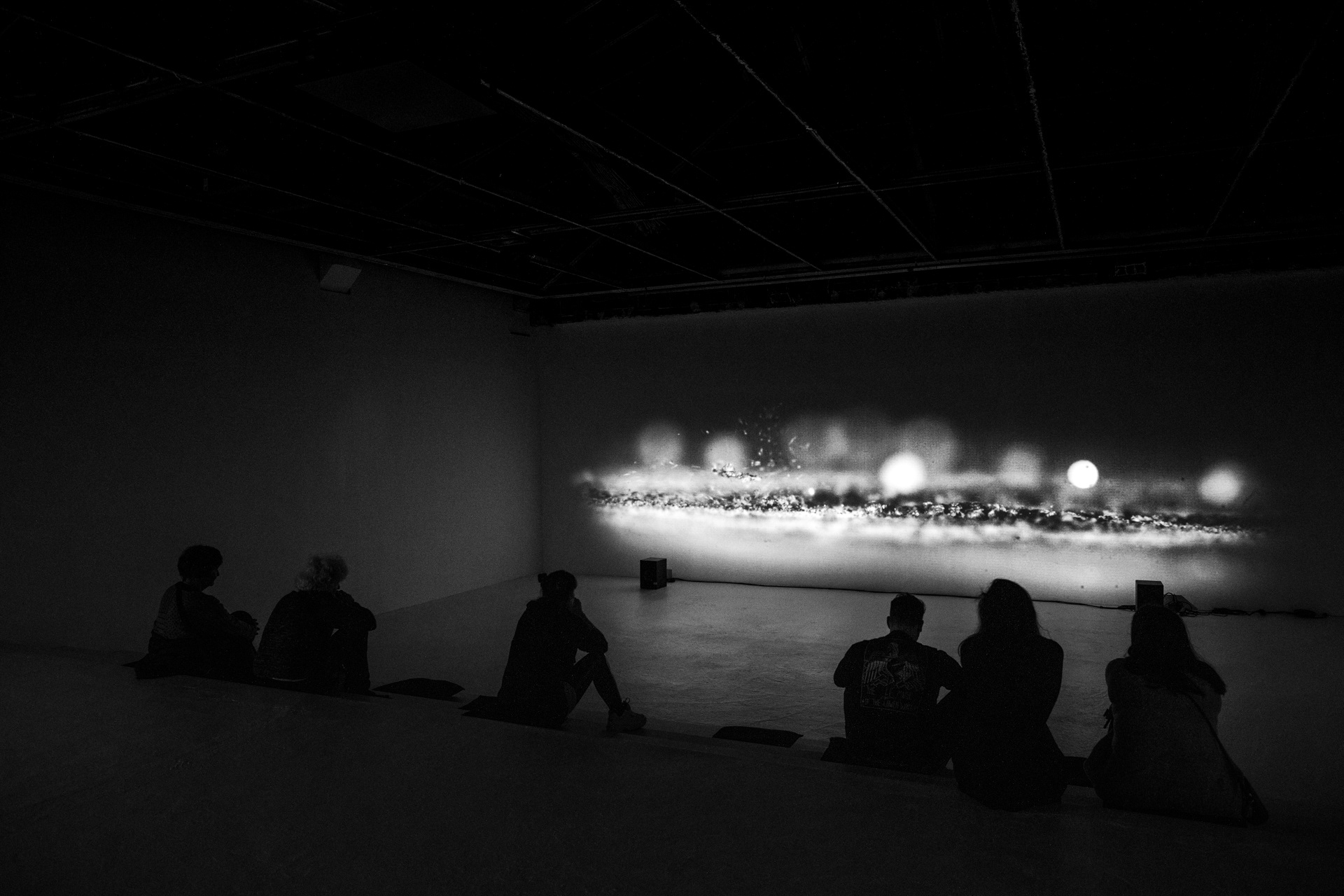
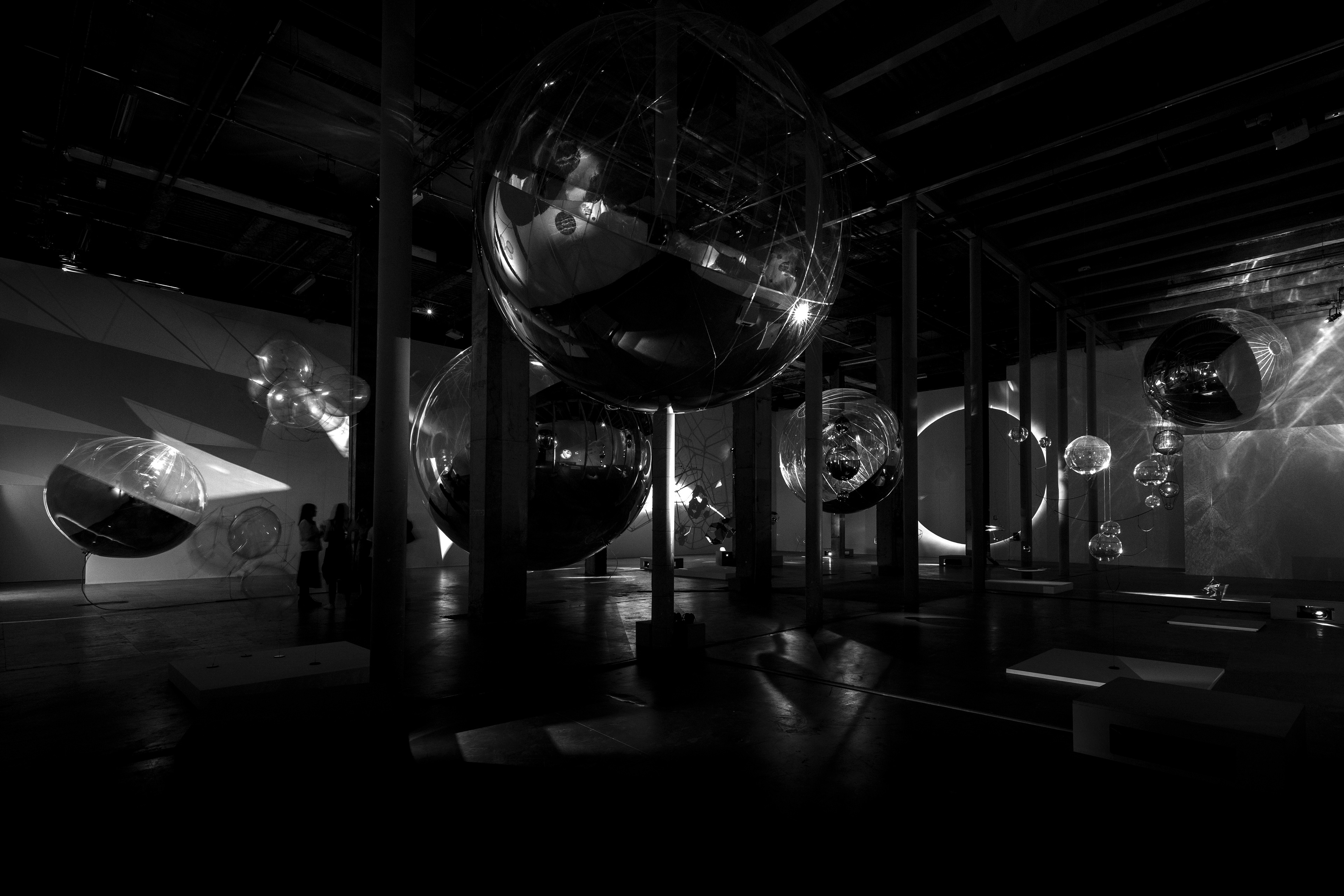
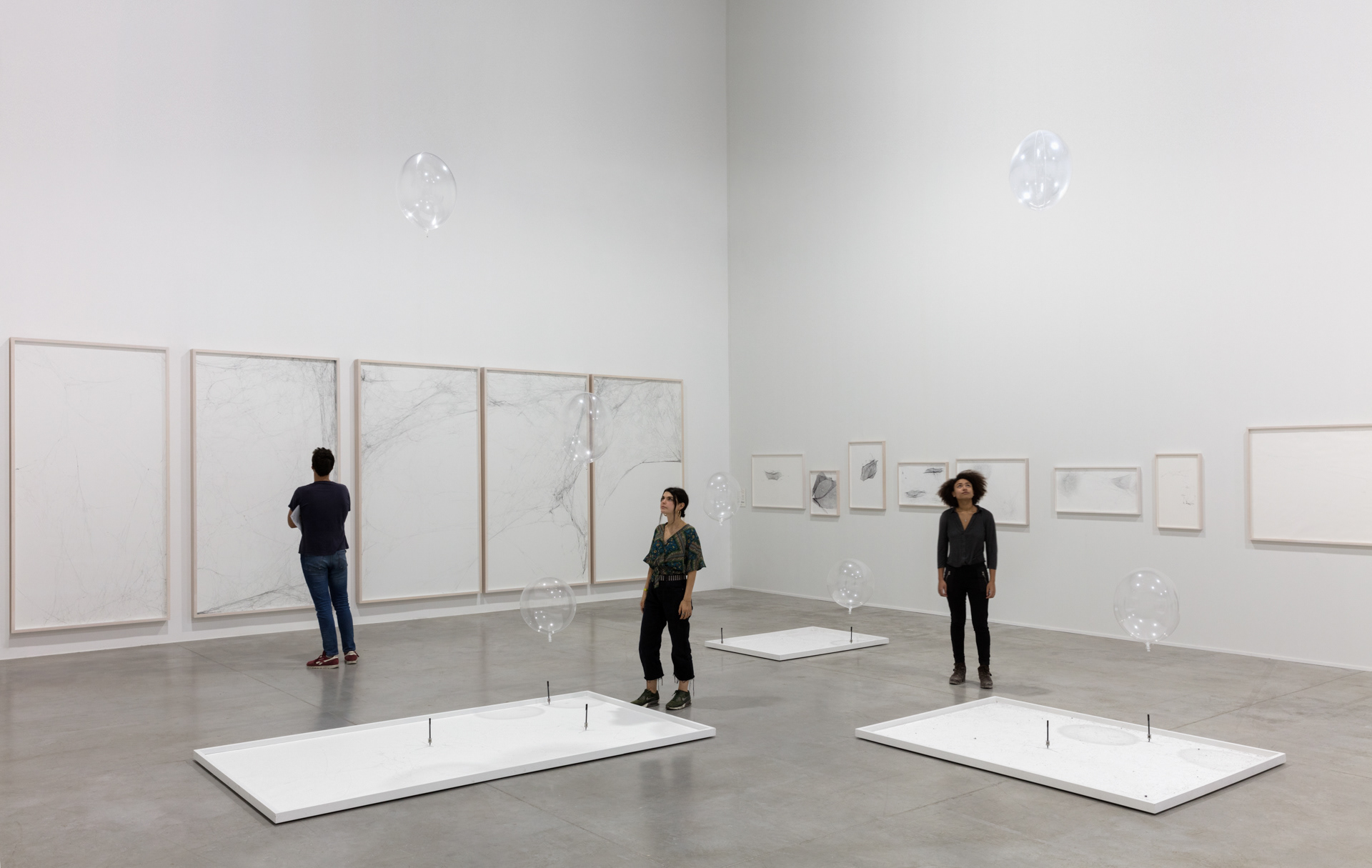

A Thermodynamic Imaginary
By Tomás Saraceno, at MAAT, Lisbon, Portugal, 2018
In August 1709, the Portuguese priest and naturalist Bartolomeu de Gusmão accomplished, for the first time, the feat of elevating a heavier-than-air object into the air. This would become the first hot air balloon ever built, preceding the Montgolfier brothers by eight decades.
Three hundred years later, artist Tomás Saraceno (b. 1973) began to create sculptures which defy gravity, floating in the air merely heated by the sun, leaving behind the use of helium or fuel. These pieces also form the basis for the Aerocene Foundation which, as the artist explains, “embodies a new interplanetary ecology of practice which could reconnect with elemental sources of energy and strata coming from the sun and other planets, breaking the boundaries of the sublunary. We can now think to move together towards an aerosolar ethos, embodying an ever more entangled relationship with the atmosphere, the air and the cosmos.”
A Thermodynamic Imaginary presented a new immersive ensemble of sculptures from this ongoing project, including existing and new pieces that allowed us to imagine the possibility of an “aerocene” urbanism, as well as a futuristic view of new attunements between humans, more-than-human beings and the Earth system, reaching an ethical commitment with the sun, the atmosphere, and the planet.
AW 1 Aeroke, 2018
ø 2.0 m, ø 3.0 m / Media installation / Mylar transparent and metalized, tape, pump with overpressure release valve, polyester rope, microphone, headphones
ø 2.0 m, ø 3.0 m / Media installation / Mylar transparent and metalized, tape, pump with overpressure release valve, polyester rope, microphone, headphones
AW 2A DH Tau b/M+Mb, 2016
H 55 x 71 x 56 cm / Cloud / Metal, mirror panels, polyester rope, fishing line, metal wire, steel thread
H 55 x 71 x 56 cm / Cloud / Metal, mirror panels, polyester rope, fishing line, metal wire, steel thread
AW 2B LEDA 33452/M+Mb”, 2016
H 89 x 106 x 71 cm / Cloud / Metal, black panels, polyester rope, fishing line, metal wire, steel thread
H 89 x 106 x 71 cm / Cloud / Metal, black panels, polyester rope, fishing line, metal wire, steel thread
AW 2C RAY 299 792 458, 2017
H 125 xW 162 x D 162 cm, sphere ø 20 cm / Glass sculpture / Carbon fibre, rope, metal, fishing line, borosilicate glass
H 125 xW 162 x D 162 cm, sphere ø 20 cm / Glass sculpture / Carbon fibre, rope, metal, fishing line, borosilicate glass
AW 2D RAY 193, 2017
H 45 x W 60 x D 60 cm, sphere ø 5 cm / Glass sculpture / Carbon fibre, rope, metal, fishing line, mirror crystal
H 45 x W 60 x D 60 cm, sphere ø 5 cm / Glass sculpture / Carbon fibre, rope, metal, fishing line, mirror crystal
AW 2E Aerocene Constellation 22.5/55/19.5/36/15.5, 2018
H 230 x W 56 x D 56 cm / Glass sculpture / Rope, metal, fishing line, borosilicate glass
H 230 x W 56 x D 56 cm / Glass sculpture / Rope, metal, fishing line, borosilicate glass
AW 2F Calder Upside Down 38/29/24/18/15/12/12, 2013
ø 12, ø 12, ø 15, ø 18, ø 25, ø 30, ø 39 cm / Glass sculpture / Rope, metal, fishing line, glass
ø 12, ø 12, ø 15, ø 18, ø 25, ø 30, ø 39 cm / Glass sculpture / Rope, metal, fishing line, glass
AW 3 Aerocene Explorer Backpack AE010, 2016
H 52 x 40 x 18 cm / Flying sculpture / mallard, fabric, various materials
H 52 x 40 x 18 cm / Flying sculpture / mallard, fabric, various materials
AW 4 Thermodynamic Suite, 2018
150 x 200 cm (dimensions of the drawing board) / Prints and drawings / Wooden board, paper, balloon, pen, plexiglass, rope
150 x 200 cm (dimensions of the drawing board) / Prints and drawings / Wooden board, paper, balloon, pen, plexiglass, rope
AW 5A Tata Inti, 2018
H 150 x 200 cm / Video work / Single channel video, 16:9, FullHD, black and white, stereo, 4’16’’.
H 150 x 200 cm / Video work / Single channel video, 16:9, FullHD, black and white, stereo, 4’16’’.
AW 5B 163000 Light Years, 2016
H 400 x 225 cm / Video work / Single channel video, 16:9, FullHD, black and white, stereo, 4’16’’.
H 400 x 225 cm / Video work / Single channel video, 16:9, FullHD, black and white, stereo, 4’16’’.
Photographs courtesy of Studio Tomás Saraceno

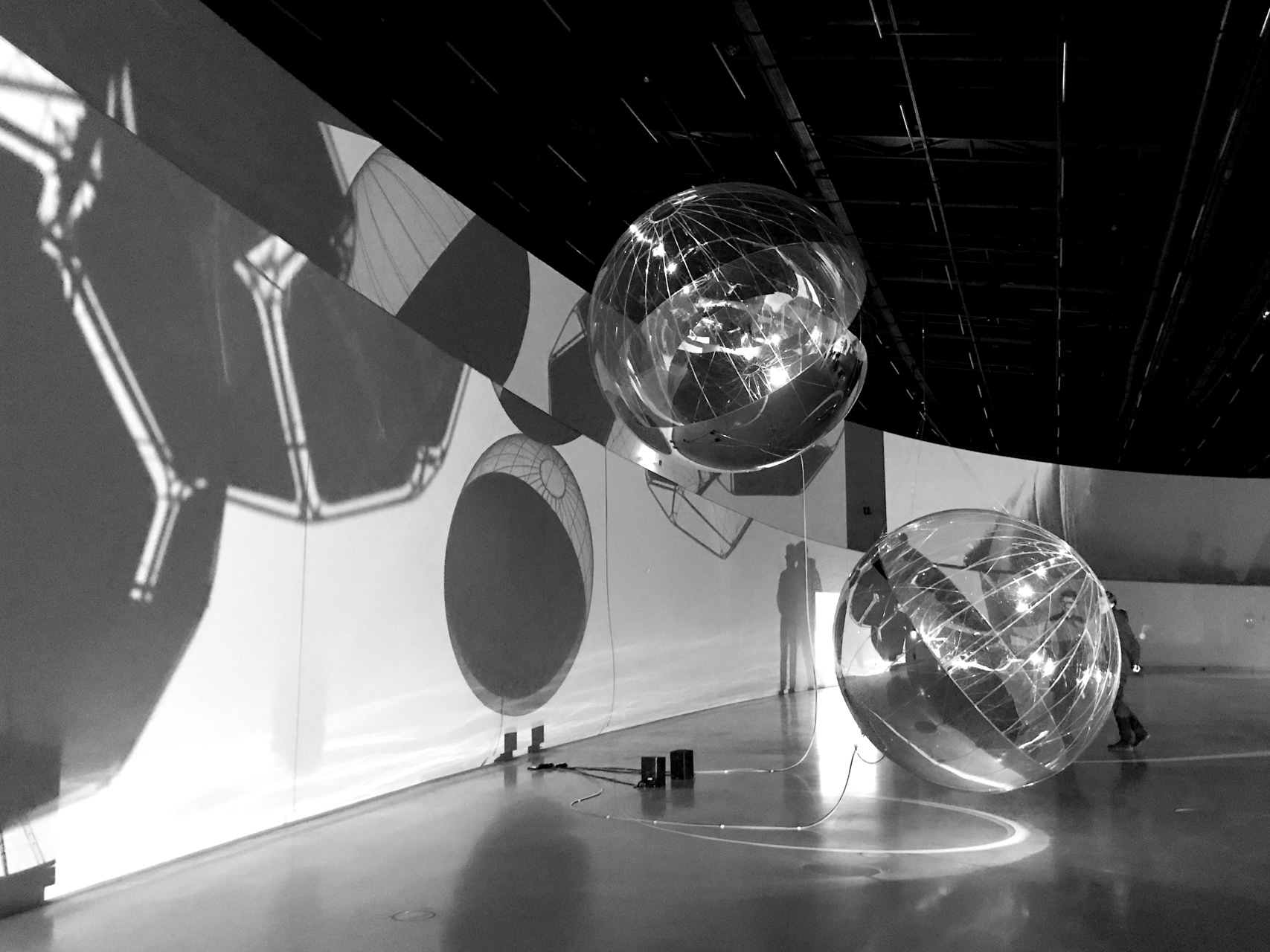


Architecture des humeurs
by R&Sie(n) - New Territories, at Le Laboratoire, Paris, France, 2009
This experiment presents the opportunity to interrogate an obscure area that could be called “the emission of desires” through the capture of physiological signals based on neurobiological secretions, and to implement a chemistry of the “humeurs” of future citizens, taken as inputs generating a diversity of habitable morphologies and the relationships between them. This research is directly influenced by the concepts of ‘’body without organ’’ and a ‘’desirable machine’’ of Antonin Artaud and Gilles Deleuze.
The groundwork for this architecture of “humeurs” is a rereading of the contradictions inherent in the expression of these desires, both those that traverse public space through the ability to express a choice by means of language, on the surface of things, and those that are underlying and perhaps more disturbing but just as valid. By means of the latter we can consider the body as a desiring machine with its own chemistry – with dopamine, hydrocortisone, melatonin, adrenaline and other molecules secreted by the body itself that are imperceptibly anterior to the consciousness these substances generate. Thus the making of architecture is inflected by another reality, another complexity, that of the acephalous body, the animal body.
Photographs courtesy of R&Sie(n)

